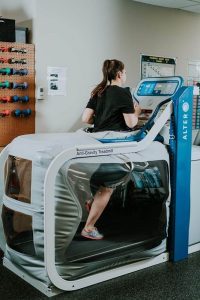

In an ideal world, I’d do one session a week for the 12 weeks of my marathon training, but I’m already a few weeks in, and Bradley assures me I’ll see a difference in just three. And because I’m lighter, I can train harder, and for longer. It equates to just a fifth of my body weight hitting my joints. How? I weigh 9st 2lb but, on the AlterG, I can weigh as little as 1st 12lb. ‘Training just once a week on the AlterG can reduce cumulative load on your body, while ensuring you get the same cardio workout as normal running.’ How often you're meant to run on an anti-gravity treadmill ‘The strain of running over long periods puts you at risk of overuse injuries, such as Achilles, knee or hip issues,’ says Tom Bradley, clinical manager at the Pure Sports Medicine Clinic – home to one of seven AlterG units in London. Dubbed the ‘anti-gravity treadmill’, it uses air pressure to reduce your body weight by up to 80% in a bid to ease the load on your muscles and joints. I’m training on the AlterG – the newest form of ‘prehab’ (future-proofing your body against injury). While my fellow gym-goers are rocking Lululemon and the like, I’m wearing a fetching pair of bespoke tight black shorts, designed to seal my lower body into a sort of Zorb for my legs. It’s 7.30pm on a Thursday and I’m smashing out 10km on a treadmill in central London in the name of marathon training. Now that's a lot.Īnd, the all-important question: does it really work in real life? Keep reading to find out what happened when WH's junior digital writer Ally Head ( put her legs to the test. The best bit? It can reduce impact by up to a whopping 80%. How does it work? Well, cleverly designed by NASA scientists, the treadmill uses air pressure to reduce your body weight and, in turn, reduce the load on both your muscles and joints.
No gravity treadmill plus#
Check it out their array of treadmills, plus take advantage of their fast, free shipping.Anti-gravity treadmill training has been dubbed the latest form of prehab on the market to future-proof your body from injury and save your precious pennies on physio bills. While you may not be able to purchase an anti-gravity treadmill on Amazon, this is still the best place to find great pieces of home gym equipment at the lowest prices. Where to buy the best anti-gravity treadmill? Does cardio on regular machines feel excessively painful, or are you having trouble exercising because of your size? Are you having a tough time recovering from a recent or chronic injury? If you've answered yes to any of these questions, an anti-gravity treadmill could be a great solution. The best way to determine whether an anti-gravity treadmill is right for you is to assess your physical health. Anti-gravity treadmills are primarily used for injury recovery, rehabilitation, and joint pain, and anti-gravity exercise can even be prescribed by a physician if they think their patients will benefit from it.

If you're trying to figure out whether you need an anti-gravity treadmill, it's best to talk to your doctor or physiotherapist about this decision first. Is it worth having an anti-gravity treadmill? How much does an anti-gravity treadmill cost?Īnti-gravity treadmills do not come cheap, so if you're considering this purchase, make sure you really need it! The average anti-gravity treadmill costs about $35,000 and can cost as much as $75,000 depending on the machine's unique features. The treadmill functions like regular treadmills, but this pressurized air chamber makes movement easier and less painful. Your lower half fits inside the air chamber and is zipped closed, and the machine adjusts to your weight, allowing you to decide how much you'd like the machine to support your weight. An anti-gravity treadmill allows you to exercise at a lower bodyweight than usual, which relieves pressure and is great for recovering after injuries, rehabilitating stressed joints and muscles, and weight loss.Īnti-gravity treadmills use pressurized air chamber to lighten your bodyweight.


 0 kommentar(er)
0 kommentar(er)
